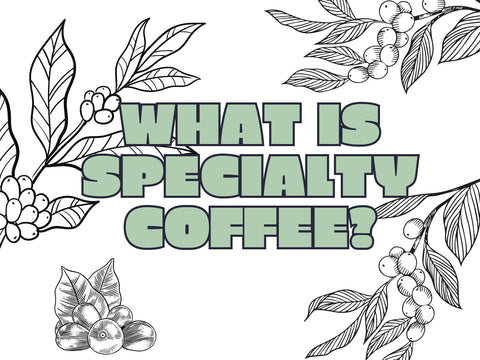Coffee is loved by billions of people worldwide, but not many coffee lovers know how the beverage that makes mornings more bearable is actually made. There’s more to it than just pouring hot water over coffee grounds.
If you want to learn what journey coffee takes until it ends up in your morning cup, you’ve come to the right place.
We’ll talk about the very beginnings (planting coffee trees), the end (your cup), and all the stages in between, like wet processing, natural processing, and coffee roasting.
Note: This is the story of whole coffee beans and ground coffee. If you’re interested in how instant coffee is made, you can check out our article on that topic, as that’s a different process and involves either freeze-drying or spray-drying.
Planting the Tree
Unlike money, coffee does grow on trees.
A coffee plant needs to be planted in a suitable climate (the best places for a coffee plant are located in the so-called coffee belt, which includes countries like Indonesia, Ethiopia, and countries in Latin America).
Depending on the species, coffee plants start to bear fruit 2-4 years after coffee seeds have been planted; with robusta coffee trees taking closer to 2 years and arabica coffee plants closer to 3-4 years.
The initial harvests usually are smaller in quantity but improve over the years as the coffee tree matures.
Harvesting
Once trees have produced coffee cherries and the coffee berries are ripe enough, they are harvested.
While many coffee farmers pick coffee cherries manually as this allows them to select only the ripe cherries, it’s also becoming more common for farms to use machinery, especially on the big commercial farms.
Sorting and Selecting
Before anything else happens, the freshly picked cherries undergo a sorting and selecting process. This step is necessary to remove any unwanted extras, e.g. twigs, defective beans, or debris. Note that this isn’t the same thing as the grading process, which takes place later.
Pulping and Processing Coffee
Once sorted, the cherries undergo pulping in a pulping machine unless they are processed via the natural method (which is a processing method during which the beans dry while still surrounded by the whole cherry) or one of the methods that are inspired by winemaking (where coffee beans are fermented while still inside the fruit).
For most other processing methods, including the wet method, the outer skin is removed to reveal the precious coffee bean within. Depending on the coffee processing method, some of the fruit’s flesh may be kept on the coffee bean.
Fermenting
Some pulped beans enter the fermentation stage (others move straight to the drying stage). This process removes the mucilage while the beans rest in water-filled fermentation tanks. This results in some unique flavor profiles.
Careful monitoring is essential to ensure optimal fermentation. If the wet processing method is used, the beans are washed after fermentation. The fermented beans then move on to the next process.
Drying
No matter which processing method is used, all beans have to be dried (though wet-hulled processed beans continue on their journey while they’re still much wetter than the beans from other methods). To dry, beans are spread out on raised beds or patios to dry under the sun.
In countries where the sun isn’t as reliable, mechanical dryers are often used to help with the drying process. The drying process is an important step in coffee production.
Storing
Once the beans are dry, it’s vital that they’re stored properly until they are taken to the next step of coffee production. Green coffee beans are stored in controlled environments to protect them from external elements. Sometimes, green beans can be stored for a few months until any further processing happens.
Milling
The journey continues with milling. During milling, any remaining layers and debris are removed from the beans. This results in coffee beans ready for the next steps in the journey.
Grading/Cupping
Quality is important, and as you know, there can be quite a price difference in coffee. The quality of coffee beans isn’t randomly decided. There’s a rather meticulous grading and cupping process involved. During these steps, proper coffee experts assess the beans based on size, weight, and overall quality.
This step ensures consistency in flavor and allows for the identification of exceptional beans that may be destined for specialty coffees and could be sold at much higher prices.
Distribution
The beans are now packaged once more and ready for journeys all over the world. Extensive coffee distribution networks transport the beans to roasters worldwide.
Roasting Process
Roasting can be done at home, but in most cases, this step is done by a professional roaster with some impressive equipment.
Roasting turns the green coffee beans into aromatic brown beans that can come in all shades of brown - from light brown, and golden brown to dark roast coffees that are almost black. Roasting plays an important part in the final flavor notes of a coffee bean.
Packaging
After roasting, another round of packaging follows (unless the roaster also does the grinding). Good packaging is important to keep the beans as fresh as possible until they arrive at their next destination.
Grinding
The grind level and quality are important for the brewing process. You can buy coffee that's ready to brew or grind it at home - but it’s important to understand which grind to use for your favorite brewing method (e.g. coarse for French press and cold brew, medium for drip, and finely ground coffee for espresso).
If you can grind freshly roasted beans at home (especially if you use arabica coffee beans), you'll be able to brew coffee that's as fresh as it could be (unless you also roast your own beans).
Brewing Coffee
We’re almost there! Brewing coffee is the moment when hot water extracts the flavors from the coffee. This can happen in various ways: through the high pressure of espresso machines, the slow drip of automatic coffee makers, the manual pour-over, and many more.
Drinking
Once you brew your coffee, the humble bean’s journey is at its end (unless you want to talk about digestion, but that’s a different story). Pour your coffee in a cup, drink it black or add some milk - be it dairy or plant-based - and some sugar, maybe even some whipped cream and coffee syrups.
There are dozens of ways to enjoy coffee!
Conclusion
As you see, there’s much work involved before you buy coffee from a roaster or in a grocery store.
Millions of people are employed in the coffee industry: from the humble coffee farmer, the operators of coffee mills, the suits in distribution offices, and of course roasters and coffee sellers in your home country and many more.
Each stage in the process plays an important role in creating the perfect cup of coffee.
When you enjoy your next cup, take a moment to appreciate the many people who were involved in getting those precious beans to you.



